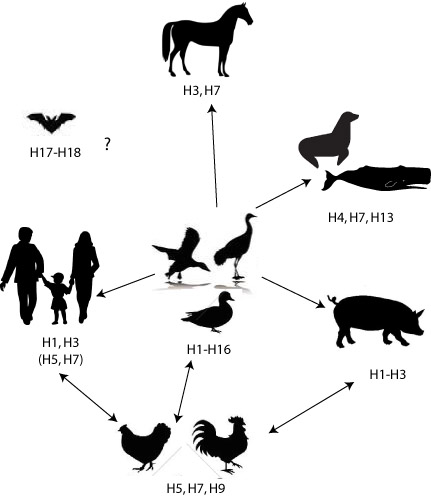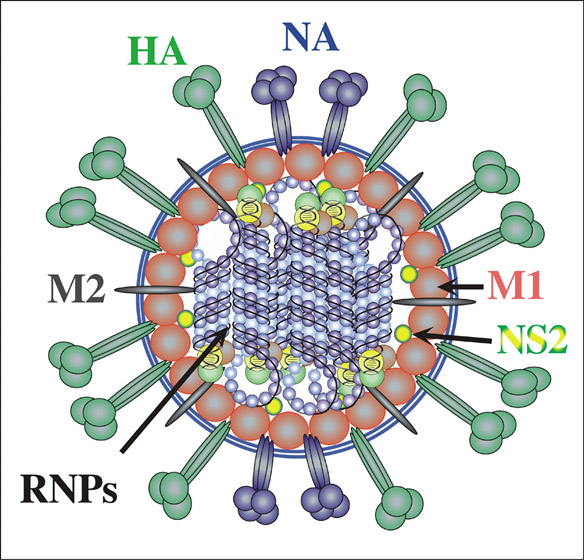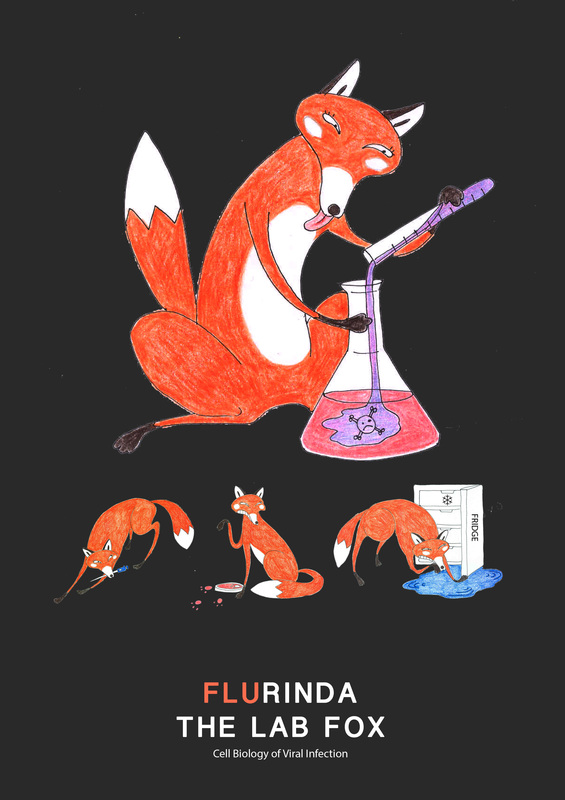|
VIRAL ECOLOGY & CLASSIFICATION:
Migratory birds constitute the main reservoir of influenza A viruses, where the infection is asymptomatic. Influenza is, however, able to infect a wide range of hosts such as humans, domesticated poultry, horses and pigs (see illustration in the right). This list is not complete and might increase as more species are analysed. As an example, recently, novel influenza subtypes were identified in bats. Viruses are distinguished based on the antigenic properties of 18 hemagglutinin (H) and 11 neuraminidase (N) proteins localized at the surface of the virion (see second illustration on the right). Influenza A viruses are further subdivided into viral strains. For example, the H1N1 strain, the cause of the Spanish Flu, no-longer circulates in humans even though yearly infections are still caused in part, by influenza subtype H1N1. This means that these two viral strains are very distinct, and that for example, vaccination against one of them will not protect against the other. INFLUENZA A VIRUS AND HUMAN HEALTH: Influenza A virus is the causative agent of a respiratory illness known as flu. Yearly, flu epidemics result in 250000-500000 deaths worldwide and wide-spread morbidity with vast economic burden, as stated by the World Heath Organization. Influenza A is also responsible for pandemic outbreaks with variable consequences, such as, the devastating 1918 Spanish flu that caused the death of approximately 50 million people, followed by the 1957 Asian and the 1968 Hong Kong flu outbreaks. The 21st century suffered its first pandemics in 2009, with a virus of swine origin, that raised major concerns in terms of public health. Another incidence that alarmed health authorities regarding pandemic threats was the high case-fatality rates associated with the avian strains H5N1 and H7N9 upon infection of humans. Several measures have been taken, including stockpiling of antivirals, and research has intensified in order to understand the pandemic potential of these strains. So far, both strains failed to sustain human-to-human transmission, although recent studies have shown that H5N1 could acquire mutations enabling it to do so. VIRAL PANDEMICS VERSUS EPIDEMICS: As explained above, influenza A viruses are specialized in infecting specific hosts. In migratory birds, infection provokes no disease. On occasion, however, strains can jump the species barrier, and cause infections in other species. Novel infections in humans include the above mentioned avian H5N1 and H7N9. However, as just referred, these strains have not yet established themselves in the population on account of limited human-to-human transmission. Influenza strains have, however, successfully adapted to humans with examples including the H1N1, H2N2 and H3N2 that provoked deadly pandemics. Pandemics are global, severe forms of the disease. Although H2N2 is no longer circulating in humans, H1N1 and H3N2 are, and give rise to the yearly epidemics mentioned above. Epidemics provoke seasonal peaks of disease with excess mortality and that is why it is also referred to as seasonal flu. Influenza A virus is prone to rapid evolution with acquisition of mutations, some of them able to modify hemagglutinin and neuraminidase antigenic viral proteins. This type of evolution, called antigenic drift, permits viral escape to host immune defenses and persistence in the human population. THE VIRUS: The virion contains three proteins embedded in a host-derived lipid bilayer: H, N and Matrix 2. The viral protein Matrix 1 is located beneath the surface and separates the interior of the virion from the lipid membrane. The interior accommodates the viral genome which is of negative polarity, RNA and segmented. Overall there are 8 viral segments that encode 10 essential, and 7 additional accessory proteins. VIRAL-CELL CYCLE: Viral propagation is a complex process that starts with viral attachment to sialic acid located at the surface of lung epithelial cells and entrance via endocytosis. Upon escaping the endocytic pathway, viral genomic segments are delivered to the cytoplasm, and access the nucleus where transcription and replication occurs. However, to produce progeny virions, the newly synthesized genome needs to reach viral assembly zones in the apical plasma membrane, thus requiring nuclear export and efficient transport to these locations. To form an infectious particle, 8 different RNA segments must join 5 additional viral structural proteins resulting in budding from the host cell membrane. Therefore, an important part of the life cycle is to transport all constituents to the same site at the plasma membrane. Note: For simplicity, we have not cited scientific papers in our website. However, the text herein written is a product of the hard work of many scientists that contributed to the understanding of influenza ecology, transmission, human disease and lifecycle. |
Influenza A virus ecology.
Influenza A virion. Illustration by Prof Paul Digard, Roslin Institute, UK.
Influenza A virus cell cycle.
Meet our lab fox, Flurinda: the evil saboteur of our favourite experiments.
History: Flurinda has been a graduate student of the lab midget. The activities associated with Flurinda include: - reverse wires in power packs so that all samples loaded in an acrylamide gel come out. - contaminate the cells as you seed them to perform that important experiment. - add DNA to water prior to the preparation of a PCR mix. |




